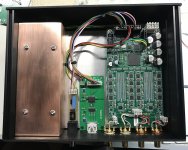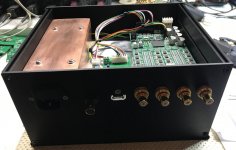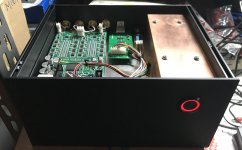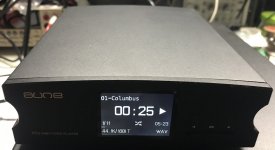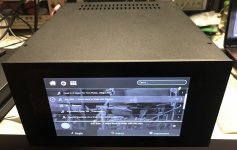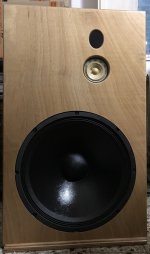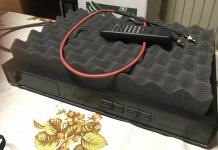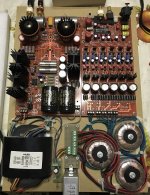Yes. I hope. Provided the source passes "bit perfect". But up to now(!) I didn't find anything of that, what you are describing.
It's simply a question of system architecture, I have explained several time how you can fully isolate the DAC from the source, and it's exactly what we are doing with our new FIFOs (Lite and Top end).
Of course it's more expensive, but the way is clear.
I believe MSB Tech has used a similar way to isolate the DAC from the source, since they use optic fiber cables to connect the source to the DAC and mostly they use SOTA fixed oscillators close to the DAC (the source is slaved).
Good - if you didn't get any followup questions on your answers I suppose the ones which asked the questions are satisfied. Your test will prove nothing of what we have been discussing here lately. It will show something else - what, I really cant help you with. Do you know yourself? Timing - could that be wander?
//
So which tests do you trust? THD?
And then you complain because the dac is source dependent?
Don't worry, THD is 0.0000000% so you can live happy.
Well, you have clarify yourself your ideas first.
Yes I complain that it is source dependent due to the implementation of the DPPL. But not that the Si514 clock has too high PN/jitter but that the clock is constantly adjusted in frequency This is what you don't seem to be able to grasp even if I have now typed it - what - 5 times... during the course of the last week.
Tell me, given what I said just now, how will your test help me?
//
Tell me, given what I said just now, how will your test help me?
//
Again: YES!
But you have to do the proof of concept. I believe in it.
I'm an hobbyist, it will take long time.
We have already demonstrated we can achieve SOTA performance with diy audio devices.
But I believe that MSB Tech has already proved that.
But keep in mind that you cannot do that with a small board for few hundred Euro, its' not possible.
But keep in mind that you cannot do that with a small board for few hundred Euro, its' not possible.
I never thought that.
Yes I complain that it is source dependent due to the implementation of the DPPL. But not that the Si514 clock has too high PN/jitter but that the clock is constantly adjusted in frequency This is what you don't seem to be able to grasp even if I have now typed it - what - 5 times... during the course of the last week.
Tell me, given what I said just now, how will your test help me?
//
Since you ask me for math formulas, please explain your PLL theory with math function, please explain how the frequency adjustment affects the digital to analog conversion.
Maybe this affects the phase of the signal?
And so can we call it "phase noise"?
I cannot update the firmware of the DAM.
I will measure the phase noise of the master clock and the LRK, and I will also measure the accuracy of the ladder.
I will upgrade my DAM and then I will make the same measurements with listening comparison.
Is it not enough for you? It does not help you?
Sorry, I cannot do more.
Last edited:
"Maybe this affects the phase of the signal?
And so can we call it "phase noise"?"
Actually - I give up. Sorry. I cant interact with you on this particular matter anymore - its too painful.
Call me a quitter? - it's OK.
//
Well, my assumptions are wrong.
What is your technical explanation?
With numbers and formulas please, in the same manner you are asking to me.
TNT, Andrea, I’m no moderator but let me just say I enormously appreciate all the contributions and hardship *both* of you have been showing on these forums both here and in other threads. I would consider it a loss if either of you quit any thread should it come to that. Can we agree to disagree on these particulars and move forward from there? A well-meant cheers to both of you.
TNT, Andrea, I’m no moderator but let me just say I enormously appreciate all the contributions and hardship *both* of you have been showing on these forums both here and in other threads. I would consider it a loss if either of you quit any thread should it come to that. Can we agree to disagree on these particulars and move forward from there? A well-meant cheers to both of you.
Thanks for the appreciation, as far as I'm concerned there is no problem, I have collected a long series of insults so I'm not worried if someone give up.
Maybe when someone continues asking me for the mathematical explanation of my assumptions he should provide some technical explanation of his assumptions.
Yes, I also would appreciate it if you guys would both stay on board.
Myself, I am still on the fence, since nothing has been proven or disproven. To me it's clear that performance does change with the source, but it could very well be that this is a byproduct of the re-clocking setup. It's why I'm asking all the time for Soeren to update the re-clocking and give us more control over it's settings, so we don't have to jugle with several variables in the equation all at once.
Myself, I am still on the fence, since nothing has been proven or disproven. To me it's clear that performance does change with the source, but it could very well be that this is a byproduct of the re-clocking setup. It's why I'm asking all the time for Soeren to update the re-clocking and give us more control over it's settings, so we don't have to jugle with several variables in the equation all at once.
There is no re-clocking in the 1021. It is a DPLL.
Re-clocking is when you use a clean clock to give a dirty clock the better performance of the clean clock. NB, both clock in this case needs to be in the same clock domain (i.e. synchronous). In the (D)PLL case, there are 2 different clock domains involved.
In the 1021 case, the clock get dirty by being handled by/through the FPGA. But no cleaning is performed by Re-clocking. It was introduced in the 1121 and later products I believe.
//
Re-clocking is when you use a clean clock to give a dirty clock the better performance of the clean clock. NB, both clock in this case needs to be in the same clock domain (i.e. synchronous). In the (D)PLL case, there are 2 different clock domains involved.
In the 1021 case, the clock get dirty by being handled by/through the FPGA. But no cleaning is performed by Re-clocking. It was introduced in the 1121 and later products I believe.
//
Listening session in progress
Finally I got my DAM1021 running so I'm evaluating its sound performance.
The setup used for the listening session is:
- Aune X5S sd card player with s/pdif output
- Raspberry PI standalone source with I2S output
- the old but still good sounding QUAD 405.2 ampli (at least with easy load)
- open baffle speaker with the Coral holey basket Alnico full range driver
The DAM1021 will be compared in the same setup to:
- Naim Audio CD3 cd player with the TDA1541A DAC
- AD1865 diy DAC with S/pdif input
- the DAC inside the AUNE X5S (DSD1793)
Music materials:
Mary Black - Columbus (16 bit/44.1kHz)
Eric Bibb - I Want Jesus to Walk with Me (16 bit/44.1kHz)
Enya - Fairy Tale (16 bit/44.1kHz)
The Eric Westberg Vocal Ensemble - Sanctus (16 bit/44.1kHz)
G.Karr - Gavotte in D Major (16 bit/44.1kHz)
Tsai Chin - Buliao Qing (16 bit/44.1kHz)
Maura O'Connell - If you love me (16 bit/44.1kHz)
Archie Shepp Quartet - More than you know (16 bit/44.1kHz)
Prokofiev - The Dance Of The Knights (16 bit/44.1kHz)
Stefan Milenkovich - Violin Concerto no.2 in B Minor (16 bit/44.1kHz)
Carol Kidd - When I dream (16 bit/44.1kHz)
Carol Kidd - You Don't Bring Me Flowers (16 bit/44.1kHz)
Daniel Baremboim Beethoven - Piano Sonata No.23 Appassionata (16 bit/44.1kHz)
Steve Howe - Bachianas Brasileiras No. 5 (Aria) (16 bit/44.1kHz)
Steve Howe - Cantata No. 140 (Wachet Auf) (16 bit/44.1kHz)
Focus - Carnival fugue (16 bit/44.1kHz)
Steven Wilson - The Watchmaker (16 bit/44.1kHz)
John Campbell - Down In The Hole (16 bit/44.1kHz)
Hans Theessink - Mississipi (16 bit/44.1kHz)
Hugh Masekela - Stimela (The Coal Train) (16 bit/44.1kHz)
Jocelyn B. Smith - When I Need You (16 bit/44.1kHz)
Damien Rice - Cannonball (16 bit/44.1kHz)
Patricia Barber -Let it rain (16 bit/44.1kHz)
Trondheimsolistene - Britten Simple Symphony Op 4 (24 bit/192kHz)
Marianne Beate Kielland & Sergej Osadchuk - From Let Us Garlands Bring, Op.18: Come Away, Death (24 bit/192kHz)
Christian Grøvlen - Chromatic Fantasia and Fugue in D minor, BWV 903: Fantasia (24 bit/176.4kHz)
HOFF ENSEMBLE - Blågutten (24 bit/192kHz)
Hoff Ensemble: Jan Gunnar Hoff, Audun Kleive & Anders Jormin - Innocence (24 bit/176.4kHz)
Nidarosdomens jentekor & TrondheimSolistene - Arnesen: MAGNIFICAT 4. Et misericordia (24 bit/192kHz)
The Staff Band of the Norwegian Armed Forces / Ole Kristian Ruud - Bozza: Children’s Overture (24 bit/192kHz)
Engegård Quartet - Haydn String Quartet In D, Op. 76, No. 5 - Finale - Presto (24 bit/192kHz)
Tone Wik & Barokkanerne - VIVALDI Cantata Rv 679: Che Giova Il Sospirar, Povero Core - Aria: Cupido, Tu Vedi (24 bit/192kHz)
Finally I got my DAM1021 running so I'm evaluating its sound performance.
The setup used for the listening session is:
- Aune X5S sd card player with s/pdif output
- Raspberry PI standalone source with I2S output
- the old but still good sounding QUAD 405.2 ampli (at least with easy load)
- open baffle speaker with the Coral holey basket Alnico full range driver
The DAM1021 will be compared in the same setup to:
- Naim Audio CD3 cd player with the TDA1541A DAC
- AD1865 diy DAC with S/pdif input
- the DAC inside the AUNE X5S (DSD1793)
Music materials:
Mary Black - Columbus (16 bit/44.1kHz)
Eric Bibb - I Want Jesus to Walk with Me (16 bit/44.1kHz)
Enya - Fairy Tale (16 bit/44.1kHz)
The Eric Westberg Vocal Ensemble - Sanctus (16 bit/44.1kHz)
G.Karr - Gavotte in D Major (16 bit/44.1kHz)
Tsai Chin - Buliao Qing (16 bit/44.1kHz)
Maura O'Connell - If you love me (16 bit/44.1kHz)
Archie Shepp Quartet - More than you know (16 bit/44.1kHz)
Prokofiev - The Dance Of The Knights (16 bit/44.1kHz)
Stefan Milenkovich - Violin Concerto no.2 in B Minor (16 bit/44.1kHz)
Carol Kidd - When I dream (16 bit/44.1kHz)
Carol Kidd - You Don't Bring Me Flowers (16 bit/44.1kHz)
Daniel Baremboim Beethoven - Piano Sonata No.23 Appassionata (16 bit/44.1kHz)
Steve Howe - Bachianas Brasileiras No. 5 (Aria) (16 bit/44.1kHz)
Steve Howe - Cantata No. 140 (Wachet Auf) (16 bit/44.1kHz)
Focus - Carnival fugue (16 bit/44.1kHz)
Steven Wilson - The Watchmaker (16 bit/44.1kHz)
John Campbell - Down In The Hole (16 bit/44.1kHz)
Hans Theessink - Mississipi (16 bit/44.1kHz)
Hugh Masekela - Stimela (The Coal Train) (16 bit/44.1kHz)
Jocelyn B. Smith - When I Need You (16 bit/44.1kHz)
Damien Rice - Cannonball (16 bit/44.1kHz)
Patricia Barber -Let it rain (16 bit/44.1kHz)
Trondheimsolistene - Britten Simple Symphony Op 4 (24 bit/192kHz)
Marianne Beate Kielland & Sergej Osadchuk - From Let Us Garlands Bring, Op.18: Come Away, Death (24 bit/192kHz)
Christian Grøvlen - Chromatic Fantasia and Fugue in D minor, BWV 903: Fantasia (24 bit/176.4kHz)
HOFF ENSEMBLE - Blågutten (24 bit/192kHz)
Hoff Ensemble: Jan Gunnar Hoff, Audun Kleive & Anders Jormin - Innocence (24 bit/176.4kHz)
Nidarosdomens jentekor & TrondheimSolistene - Arnesen: MAGNIFICAT 4. Et misericordia (24 bit/192kHz)
The Staff Band of the Norwegian Armed Forces / Ole Kristian Ruud - Bozza: Children’s Overture (24 bit/192kHz)
Engegård Quartet - Haydn String Quartet In D, Op. 76, No. 5 - Finale - Presto (24 bit/192kHz)
Tone Wik & Barokkanerne - VIVALDI Cantata Rv 679: Che Giova Il Sospirar, Povero Core - Aria: Cupido, Tu Vedi (24 bit/192kHz)
Attachments
The dam1021 is easier to DIY, the dam1121 is intended for OEMs (but also sold to consumers in single quantities) and requires a bit more tinkering.
TOTL dam1021 vs TOTL dam1121:
oscillator: Si514 vs. Si570
typical jitter: 0,8 vs. 0,3 ps
reclocking: before FPGA vs. after FPGA
galvanic isolation on input: yes vs. no
THD @ -1 dB: <0,007 vs. <0,006%
S/N 20 Hz - 20 kHz: 127 vs. 129 dB unweighted
buffered output: yes vs. no
interface header pitch: 2,54 mm vs. 2 mm
power supply: on-board (single feed 7-8VAC or +/-7-15VDC) vs. requires external (separate digital +5VDC and analog +/- 5VDC)
Also agreed that using custom filters really makes it sing. Many people here have been cooking up amazing things here:
Filter brewing for the Soekris R2R
Saving you the trouble of reading through 209 pages I recommend either of the following packs:
DIYA_1021filt_noDCmode.skr : TNT's linear filter (2K taps) + EQHQ_lpbr_b4 + C128dp + NewNOS (without DC filter)
oneoclock's pack : as above but with Soekris' stock linear filter (4K taps)
I'm loving C128dp but it's not for everyone. The other filters are really good too except NewNOS in my opinion. The latter can have a distorted midrange with too much grain.
TOTL dam1021 vs TOTL dam1121:
oscillator: Si514 vs. Si570
typical jitter: 0,8 vs. 0,3 ps
reclocking: before FPGA vs. after FPGA
galvanic isolation on input: yes vs. no
THD @ -1 dB: <0,007 vs. <0,006%
S/N 20 Hz - 20 kHz: 127 vs. 129 dB unweighted
buffered output: yes vs. no
interface header pitch: 2,54 mm vs. 2 mm
power supply: on-board (single feed 7-8VAC or +/-7-15VDC) vs. requires external (separate digital +5VDC and analog +/- 5VDC)
Also agreed that using custom filters really makes it sing. Many people here have been cooking up amazing things here:
Filter brewing for the Soekris R2R
Saving you the trouble of reading through 209 pages I recommend either of the following packs:
DIYA_1021filt_noDCmode.skr : TNT's linear filter (2K taps) + EQHQ_lpbr_b4 + C128dp + NewNOS (without DC filter)
oneoclock's pack : as above but with Soekris' stock linear filter (4K taps)
I'm loving C128dp but it's not for everyone. The other filters are really good too except NewNOS in my opinion. The latter can have a distorted midrange with too much grain.
Last edited:
For no DC filter I think the link is:
https://www.diyaudio.com/forums/att...ng-soekris-r2r-diya_1021filt_nodcmode-skr-zip
//
https://www.diyaudio.com/forums/att...ng-soekris-r2r-diya_1021filt_nodcmode-skr-zip
//
What filters are you running? These make a huge difference!
I haven't RS232 port on my PC so I'm using the one coming from the factory.
- Home
- Vendor's Bazaar
- Reference DAC Module - Discrete R-2R Sign Magnitude 24 bit 384 KHz
